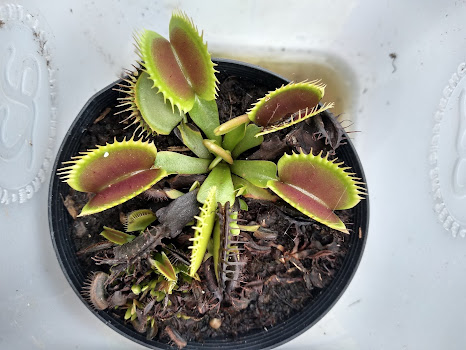I have grown a lot of varieties of thyme over the years. People often describe a variety, yet irritatingly no one ever seems to compare different varieties.
 |
| Jekkas Thyme, Tabor thyme, Lemon thyme, Orange peel thyme, Regular thyme |
I wrote a comparison of thyme varieties a while ago, and thought I would do another quick comparison.
My tabor thyme and regular thyme are just about the be phased out. They take too much effort to grow for too little reward, they grow too slowly, they don't produce enough leaves, and my Jekkas thyme has largely swamped them with its incredible vigorous growth.
Jekka's thyme grows so fast, and produces so many leaves and tremendous numbers of flowers in spring, it really is hard to go past this variety.
 |
| Five varieties of edible thyme |
All of these photos from left to right have: Jekka's thyme, Tabor thyme, Lemon thyme, Orange peel thyme, and regular kitchen thyme.
As you can see, regular thyme (on the far right) has few leaves per stem, and the leaves are small.
Orange peel thyme has tiny leaves, and the plant doesn't grow very
large, but nothing else really smells of orange peel. I am growing this
for now but will eventually lose it as it grows slow and will likely
get over run by something and starved of light.
The lemon thyme has small leaves, but makes up for that in smelling like lemons as well as thyme, and having a lot of leaves per stem.
Tabor thyme is good, it has large leaves and good numbers of leaves per stem. It needs a bit of extra water to get through summer.
Jekka's thyme (on the far left) has larger leaves and the leaves usually aren't too sparse.
 |
| Five leaves: Jekka's thyme, Tabor thyme, Lemon thyme, Orange peel thyme, Regular thyme |
It would take a lot of regular thyme to get a decent amount of leaves as they have so few leave on a stems, and the leaves are so tiny. Jekka's thyme and Tabor thyme each have a lot more leaves, and the leaves on both are much larger than regular kitchen thyme. The taste of all of these is much the same.
The incredible rate that Jekka's thyme grows and spreads means that getting a decent harvest really doesn't take too long. Any place a stem touches the soil it seems to put down roots.
 |
| Thyme leaf comparison - ruler for scale |
All of these thyme varieties seem to cope well with heavy frosts. They don't grow much over winter, but they don't die or decline either.
I know garden books always speak of how thyme is drought resistant, but none of them love dry conditions. Tabor thyme seems to perform the worst in the dry. Perhaps my garden is drier and more harsh than most, but I have never seen any variety of thyme that can survive drought without extra water.
Jekkas thyme, Tabor thyme, and regular kitchen thyme all smell and taste much the same. I sometimes think Jekka's thyme may be a little stronger, but that changes with the weather or something.
Jekka's thyme also flowers like crazy in spring, while my other varieties of thyme always flower very sparingly. The bees and other beneficial insects seem to love thyme blossom so the huge numbers of them on Jekka's thyme is a benefit to spring bees.
 |
| Jekka's thyme flowers |
 |
| Jekkas Thyme starting to flower |
Out of these thyme varieties I prefer Jekka's thyme as it is the most productive and very simple to grow. I won't grow many varieties of thyme for much longer because it is too hard stopping Jekka's thyme from overrunning the other slower growing but similar tasting varieties. There is no real point trying to protect a poor performer when I have a stand out like Jekkas thyme.
Jekkas thyme used to be rare in Australia, but I am happy to say that it is becoming far more common. I sell bare rooted Jekkas thyme plants through my for sale page, and I may sell other varieties of thyme on occasion.


























